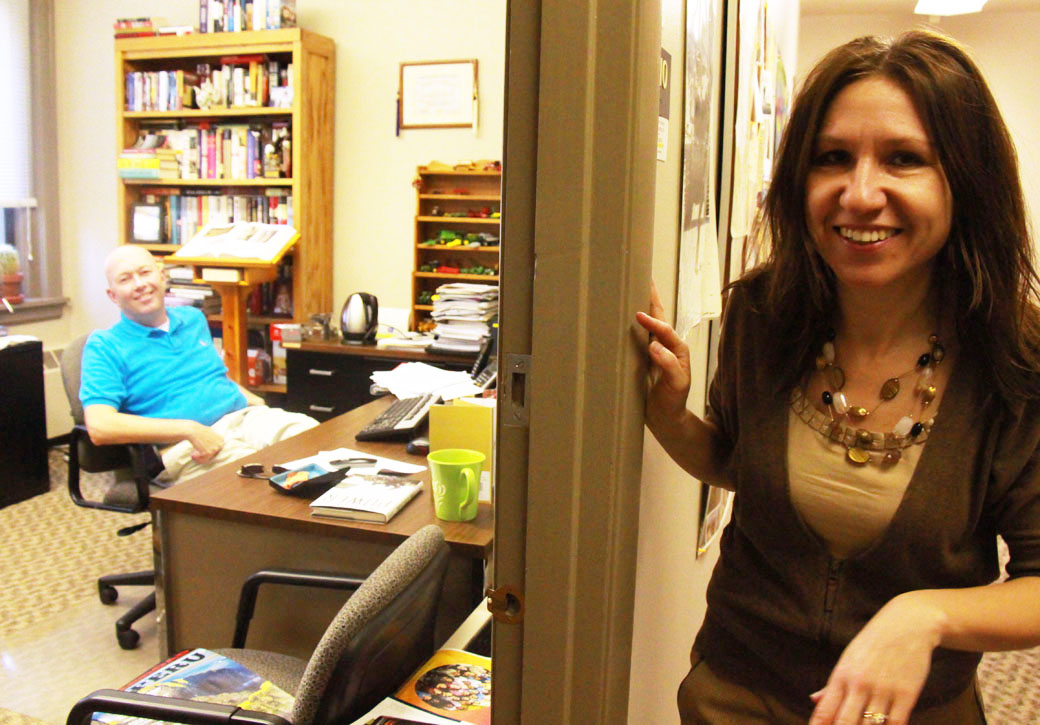
Married faculty members ‘completely integrated’ in each other’s lives
Growing up, Kelly McKay-Semmler’s parents owned a small business in western South Dakota and were able to pull off working with each other all the time. Although it’s something she has always wanted for her own life, she never thought she’d be able to replicate it.
But McKay-Semmler has done just that with her husband, Shane Semmler. The two are both professors in the Communications Studies program at the University of South Dakota.
“It’s very unusual to work with your spouse in such a close space, and I’ve always wanted that,” McKay-Semmler said. “We work together on projects and things, so it’s always a benefit to have your life completely integrated with your spouse.”
Graduate student Sama Patel has experienced the two working together through a research project in which she assisted and has taken classes with both.
“They’re both wonderful people. Dr. Semmler is extremely intelligent and he really boosts my intelligence level,” she said. “She’s good with teaching skills and communication skills and how to guide me.”
The Communication Studies department as a whole was very welcoming to her as a psychology major, Patel said, with a family-type atmosphere. Having the relationship they do did not hinder their research projects or classes, she said.
“They’re really good at keeping their professional life and personal life separate,” Patel said.
The two even started working at the university the same year, seven years ago, and also received tenure last year. Semmler said the two are both “intensely involved” in their teaching and research, which makes it easy to immediately understand each other.
“I think it can be hard for faculty members whose spouses are not also academics because our lifestyle is so intense,” he said. “I imagine it would be very difficult for non-academic couples to negotiate those crunch times.”
Semmler and McKay-Semmler aren’t the only ones working within close proximity of each other. Timothy Schorn and his wife, Ilmira Dulyanova, both work in the Political Science department.
This year marks Schorn’s 20th year at USD, while Dulyanova has been here for more than five. Their offices are even right next door to each other, something Dulyanova said she has never even heard of before.
“I was actually anxious and curious as to how it would work for both of us, but I don’t find it difficult at all,” she said. “My job is more of an administrative job, while Tim’s job is a faculty member, so he’s not here from 8-5.”
But the proximity of office space has been known to throw students off before, Schorn said.
“It does throw students off when I’m talking to them and I yell, ‘Dear!’ and they kind of look around,” he said.
Dulyanova and Schorn have also benefited from a better understanding of the other’s job, but Schorn said the two are more likely to bring their work home.
“She is now worse than I am, so we continue talking about work because we both work in the same department and on the same schedule. We know the different issues that both of us face,” he said. “And if we have an argument at home, we can’t continue the argument at work, so we just have to walk in and slam the door or something.”
Dulyanova has even noticed that sometimes she sees her spouse more at work than at home.
However, the two spend every morning together during their commute to work.
“I drop her off at work and then drop the six-year-old off at school. Then she usually takes the car to pick up the six-year-old and I’ll walk home,” Schorn said. “It’s cheaper than paying for two parking tickets.”
(Professors Tim Schorn and Ilmira Dulyanova both teach at the University of South Dakota and their offices are located in the same hallway. Katia Duszenko / The Volante)

